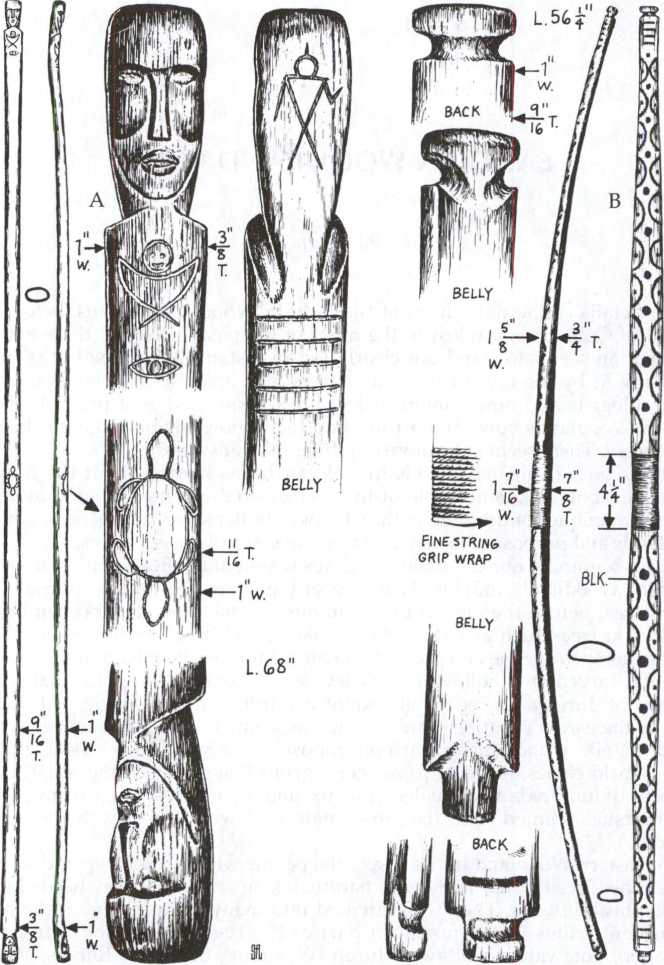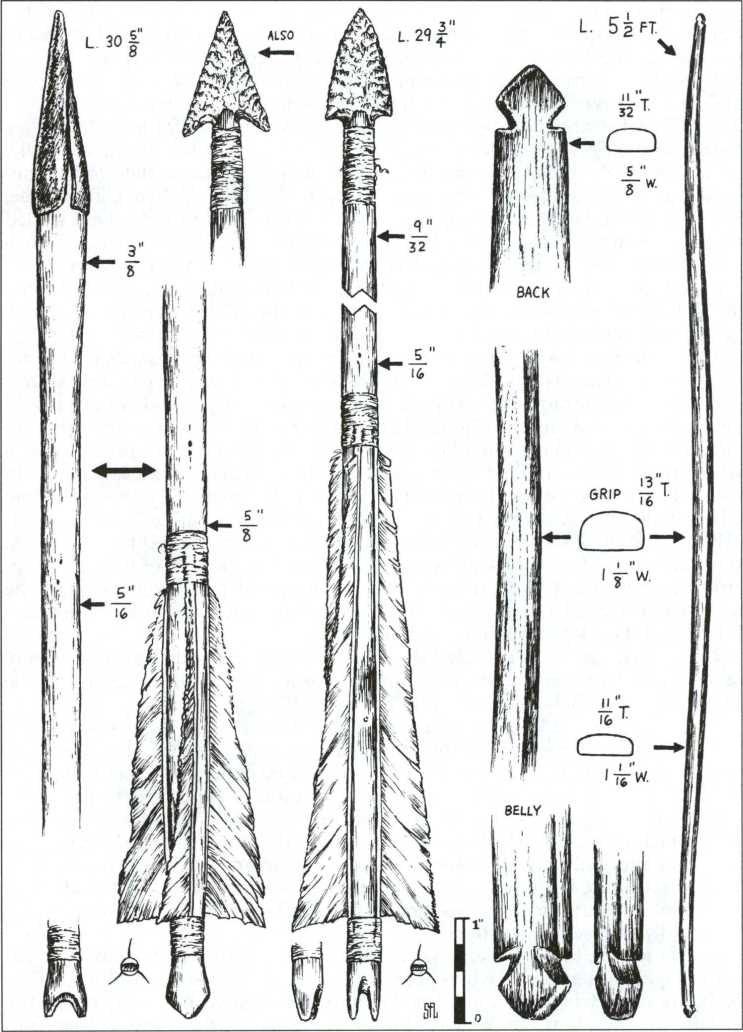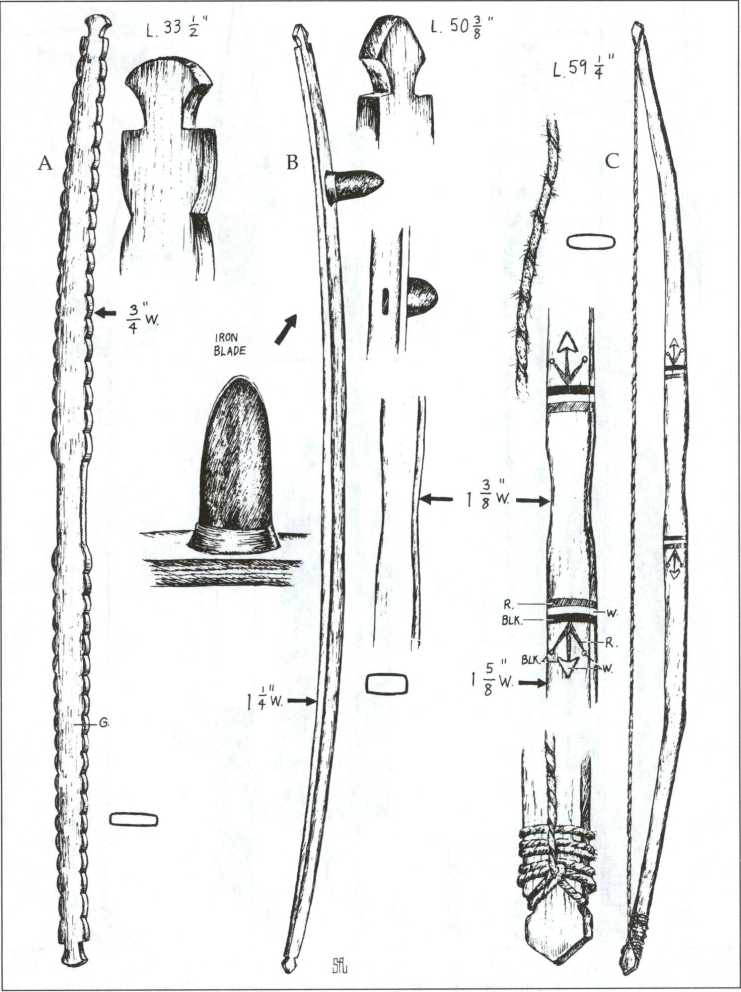Al Herrin
The details of the daily lives of the Eastern Woodland Indians, before the arrival of Columbus, are lost in the mists of the past. Here and there a bit of information seems to stand out clearly for an instant, like a tree in the forest suddenly lit by the rays of the sun, only to fade again as the clouds thicken. Archaeologists and others interested in precise knowledge of pre-Columbian Eastern Woodlands bows and arrows find their knowledge is likewise clouded by mystery. There seem to be more questions than answers.
My purpose in this chapter is to collect what is known about the Eastern Woodland bow, examine some of the unanswered questions and show that, through a unique contribution of the Cherokee Indians, we can roll back some of the clouds and propose reasonable answers to some of the questions.
Before beginning our discussion, perhaps we should define what we mean by "Eastern Woodland" Indians. That area of the United States east of the Great Plains was, before the arrival of Columbus, a vast, almost unbroken forest. Hardwood trees such as oak, hickory, maple, and beech and, in some areas, evergreens such as pine and cedar dominated. Much of the hilly or mountainous land was carved with hollows and valleys which contained countless lakes and streams of pure water fed by abundant precipitation and spring water from deep in the earth. The forests and savannahs teemed with game such as white-tail deer, elk, woods bison, caribou, moose, grizzly and black bear, timber wolves, bald eagles, flocks of passenger pigeons that darkened the sun, turkeys in flocks of hundreds and smaller game too abundant to list. The streams, lakes, and marshes teemed with fish, mammals, and waterfowl by the countless millions.
The Eastern Woodland Indians were the people who called this paradise their home. They lived in harmony with nature, taking only what they needed for a simple, healthful life. They were divided into many tribes. Some of the more prominent tribes in the northern part of the region were the Sauk, Eox, Kickapoo, Potawatomi, Ottawa, Huron (Wyandot), Shawnee, Illinois, Miami, Iroquois, Algonkin, Abenaki, Malecite, Delaware, Ojibwa (Chippewa), and Mohican. The predominant tribes in the southern part of the region were the Cherokee, Choctaw, Chickasaw, Muskogee (Creek), Seminole, Catawba, Yuchi, Natchez, Timucua, Calusa, Tekesta, Caddo, Atakapa, and Chitimacha.
I use the Cherokee Indians as representative of the Eastern Woodland Indians

A) Northeast Algonquin — possibly Delaware, patinated hickory with slight recurves, dating from the 1700's. Note carved faces on each tip, possibly a “keeper of the game" spirit to ensure good hunting; other carved figures may be clan symbols (courtesy Ranley collection).
B) Choctaw — Mississippi and Alabama, Osage orange with black painted design on back, wrapped grip (courtesy Grayson collection).

Creek — South Carolina and Georgia. Arrows fletched with white and black feathers, one arrow with glue, one without. Points (L-R), a thin piece of metal rolled into a cone around the sharpened tip, brown agate, and grey chert. Bow is hickory, dark with age. (courtesy Grayson Collection)
In this discussion. I have done so for two reasons. First, I am a member of the Cherokee Nation and, having been reared in the traditional way, have greater knowledge and insight into the culture and heritage of the Cherokee. Second, my people have made a unique contribution to the preservation of knowledge of the Eastern Woodland bow, which will be discussed a bit later.
My Cherokee ancestors occupied a vast area in the beautiful mountains they called Sa-go-ni-ge, "the place of the blue smoke," now called the Great Smoky Mountains. This homeland encompassed an area of approximately forty thousand square miles in what is now the states of Georgia, Alabama, Tennessee, South Carolina, North Carolina, and Virginia. They lived in permanent walled villages and towns, raised corn, beans, and squash in garden plots, caught fish from the streams, hunted game with bows and blowguns, and made war.
In fact, their favorite pastime was warfare with neighboring tribes including the Catawbas, Shawnees, and others. Every European observer of the colonial period remarked about the Cherokees' inordinate fondness for war. A great deal of daily life was taken up in preparing for and conducting raids on enemy towns as far away as Elorida or defending their own towns from enemy raids. The object was not to wipe out your enemy because, if you did, whom would you fight then? Around 1730, English emissaries of the crown attempted to make peace between the Cherokees and the Tuscaroras, a neighboring tribe with whom they had warred for generations. But the Cherokee chiefs said, "Should we make peace with the Tuscaroras... we must immediately look for some others with whom we can be engaged in our beloved occupation."
In the middle of the eighteenth century, the Cherokees boasted they could, on short notice, field six thousand warriors. The warlike lifestyle of the Cherokees affected every facet of their daily lives to the point that, even today, some families still use their military titles as family names such as Mankiller, Whitekiller, Fourkiller, Sixkiller, and Tenkiller.
The walled towns of the Cherokees were stoutly defended against enemy raids. James Needham, a Virginia trader, recorded the following details of the Cherokee town of Chota on the Little Tennessee River in 1673:
"The town of Chote is seated on ye river side, having ye clifts on ye river side on ye one side being very high for itts defence, the other three sides trees of two foot or over, pitched on end, twelve foot high, and on ye topps scaffolds placed with parrapets to which men stand on to fight, many nations of Indians inhabit downe this river... which they the Cherokees are at warre with and to that end keepe one hundred and fifty canoes under ye command of their forts. Ye leasts of them will carry twenty men, and made sharp at both ends like a wherry for swiftness, this forte is four square; 300: paces over and ye houses sett in streets."
Second to war, the Cherokees' next beloved occupation was the hunt. According to eighteenth-century white observers, both sexes enjoyed hunting. Other occupations of Cherokee men, less favored but deemed necessary, were the making of bows, tomahawks, war clubs, canoes, and earthenware. Women and "useless fellows" were relegated such work as gardening, tending poultry and hogs, tanning hides, smoking meat, making clothing, and the care of children.
I

Potowotomi — western Michigan, northern Indiana, and northern Illinois. Arrows fletched with two hawk tail feathers, tied with sinew at front of quill only and glued. Shallow shaft grooves spiral around arrow. Back halves of arrows stained Vermillion after fletching complete, front halves stained brown. Points of chert and iron with an unsharpened square edge (Mills County Museum, Glenwood, lA.). White wood bow showing the back, with scallops alternately painted dark orange, or red, and dark green. String is single-ply rawhide (National Museum of the American Indian).
For a Cherokee warrior, those truly were the "good old days".
In the following sections, what is known about the Eastern Woodland bow will be presented from archaeological and historical records and from other sources. Hopefully, our examination will reveal a clearer picture of the pre-Columbian Eastern Woodland bow and its use by the Native Americans of that area.
WHY WAS THE EASTERN WOODLAND BOW NOT AS WELL KNOWN AS THE PLAINS BOW?
During the twentieth century, there has been a lingering interest in the "primitive" archery of pre-Columbian Native Americans, stimulated first by the appearance, in 1911, of Ishi, the last "wild" Indian. Saxton Pope (who was Ishi's physician). Art Young, and a few others became interested in traditional archery. The interest kindled by these men lasts until the present day.
During most of the twentieth century, the little sinew-backed "horse bow" of the Plains Indians enjoyed a highly inflated reputation, while the self bow of the Eastern Woodland Indians remained practically unknown. In researching the information available on pre-Columbian Indian archery for my 1989 book, Cherokee Bows and Arrows, I found there was almost no information available on Eastern self bows. I could locate no one, outside the Cherokee Nation, who were making bows of this type. The two books which had been written at that time, American Indian Archery by Laubin and Native American Bows by Hamilton, gave most of their coverage to composite bows and especially the sinew-backed horse bow of the Plains, while giving only brief mention of the Eastern self bows. Of course, this was an inaccurate representation because the horse bow was a relatively recent development, coming after the voyages of Columbus, and was used by only a few tribes in a very limited area. Even among the Plains Indians themselves, fewer than half of their bows were sinew-backed; most were self bows. The short sinew-backed bow was simply not representative of the vast majority of pre-Columbian American Indian bows.
The horse bow gained its disproportionate fame because of the time that elapsed between the first significant European contact with what is now North America in the sixteenth century and the migration of settlers across the continent in the eighteenth and nineteenth centuries. As a result, the Eastern Woodland Indians came in contact with the white man about two hundred years earlier than did the Plains Indian.
For example, the first contact between the Cherokees and the white man was with the Spanish DeSoto expedition in 1540. During the seventeenth century, the Eastern Woodland Indians came into increasing contact with colonists from France and England. Most of the Indians west of the Mississippi River, on the other hand, saw their first white trappers and hunters during the eighteenth century followed by the intrusion of large numbers of white settlers during the nineteenth century.
Many of the Eastern Woodland Indians obtained firearms and abandoned the bow and arrow during the seventeenth century. Few white people bothered to record any details concerning the design, materials, methods of manufacture, or use of the bow and arrows of the Eastern Woodland tribes. Among the Indians,

Fox — eastern Michigan. A) Boy's bow made from white wood. B) Possibly hickory or elm, slightly narrowed at the grip. Iron blade inserted into hole in upper limb and held in place with a wedge. Base of blade tang flush with belly of bow. C) White wood with slightly narrowed handle and painted design on belly. Single strip of rawhide with hair still attached twisted into string. (National Museum of the American Indian)

Fox Arrows A) Bulbous nock with small string groove, fletched with glued feathers of either mature golden eagle or buzzard. Shafts darkened from the feathers forward, perhaps for camouflage. Steel point with drilled hole. Keith Wilbur, in Indian Handcrafts, makes the observation that perhaps steel or brass points sometimes had holes so they could be strung on a thong in lots by traders. B) Blunt carved from a single piece of wood, fletched with glued mature golden eagle feathers. C) Large blunt carved from a single piece of wood (National Museum of the American Indian).




 World History
World History









